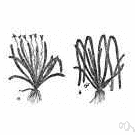However, in November 2017, during malacologie surveillance for intermediate hosts of schistosomiasis in the Mangochi District, Malawi, along the southernmost tip of Lake Malawi, 2 discrete populations of Biomphalaria snails were unexpectedly encountered in submerged beds of
Vallisneria spp.
<p class="textbox" dir="ltr">In addition to the new species, plants such as sword plants, anubias, ludwigia and bacopa stem plants and the grass- like
Vallisneria, or eelgrass, remain popular for their hardiness and beauty.
Blue-light-induced reorganization of the actin cytoskeleton and the avoidance response of chloroplasts in epidermal cells of
Vallisneria gigantea.
Thick beds of
Vallisneria carpet the bottom, and rafts of water lilies hide in tucked away corners.
For example, the invasive zebra mussel (Dreissena polymorpha (Pallas, 1771)) disperses by uprooted and drifting fragments of the submersed macrophyte
Vallisneria americana Michx.
Eichhornia crassipes, Alternanthera sessilis, Ceratophyllum demersum, Azolla pinnata, Chara coralline, Hygrorrhiza aristata, Hydrodictyon reticulatum, Hydrocotyle umbellate, Lemna minor, Salvinia, Pistia, Spirodela polyrhiza,
Vallisneria spiralis, etc.
It was found, however that massive aquatic plants such as Potamogeton crispus, Ceratophyllum demersum and
Vallisneria asiatica [12,13], and algae blooms increase the pH of water, which adversely affect the breading of mitten crabs [14].
Here we identify species-specific differences in the thermal optima of four submerged plants, Ceratophyllum demersum, Hydrilla verticillata, Myriophyllum spicatum, and
Vallisneria neotropicalis.
Kenow, "Effects of irradiance on growth and winter bud production by
Vallisneria americana and consequences to its abundance and distribution," Aquatic Botany, vol.
Aquatic vegetation, such as wild celery (
Vallisneria americana), sago pondweed (Stuckenia pectinata), and other macrophytes, are or produce important foods for waterfowl (e.g., seeds and tubers; Bellrose, 1941; Anderson and Low, 1976; Korschgen et al., 1988) and are less abundant in the Mississippi River system and IRV (Bellrose et al., 1983; Moore et al., 2010).
 Vallisneria - eelgrass; eel grass
Vallisneria - eelgrass; eel grass